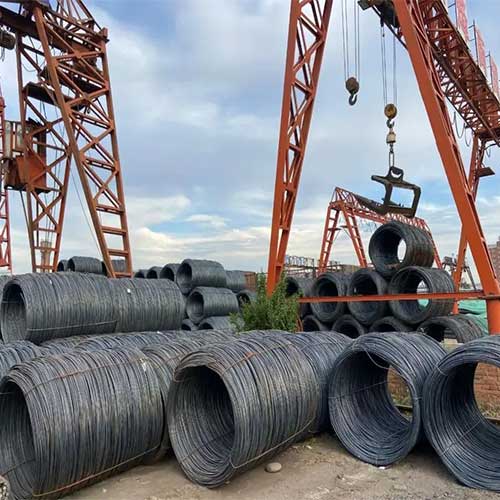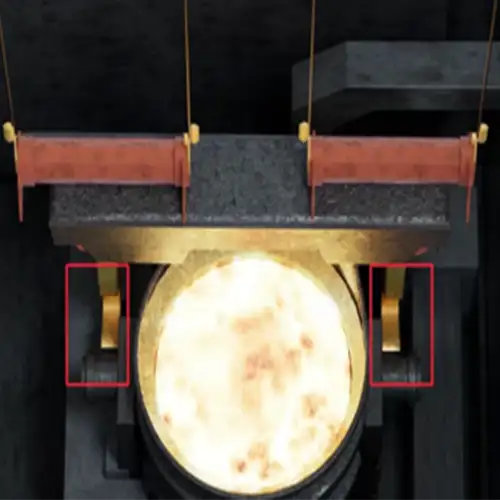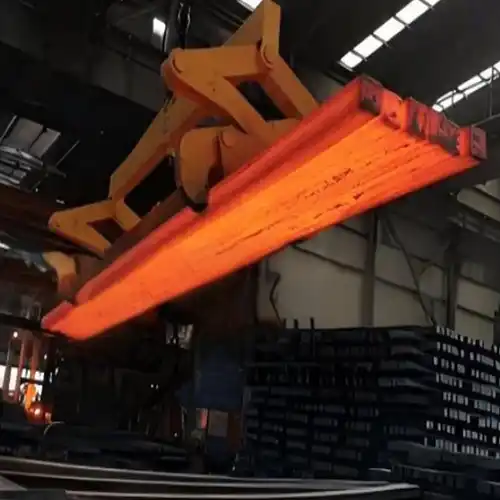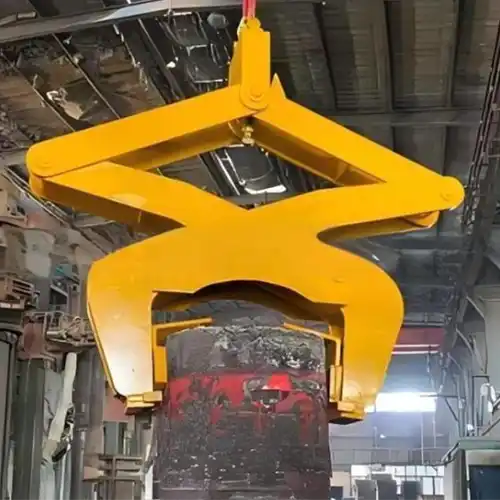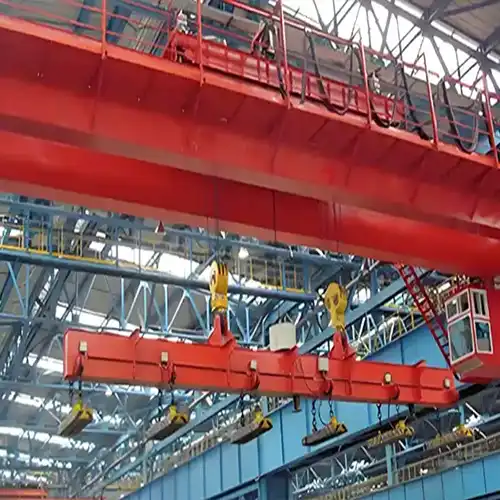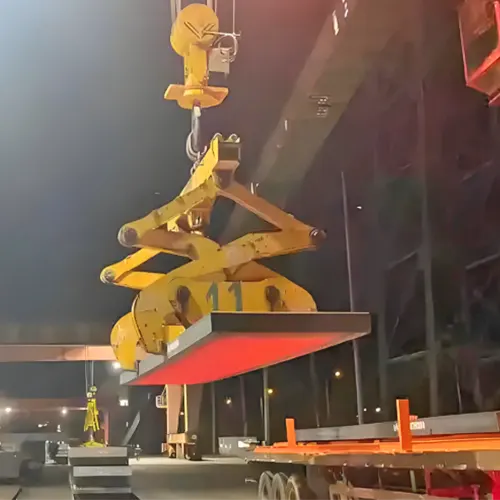Overhead Cranes 5 Ton to 50 Ton Optimizing Steel Storage Efficiency
5 tons to 50 tons overhead crane for sale.How overhead cranes & gantry cranes enhance storage efficiency in steel warehouses & steel strorage yard. Click!
Category: Steel
Your Trusted Steel Storage Overehad Cranes Manufacturer & Supplier
Overhead Cranes 5 Ton to 50 Ton Optimizing Steel Storage Efficiency
5 tons to 50 tons overhead crane for sale.How overhead cranes & gantry cranes enhance storage efficiency in steel warehouses & steel strorage yard. Click!
Overhead Cranes 5 Ton to 50 Ton Optimizing Steel Storage Efficiency
In the warehouses and industrial facilities, efficiency is the name of the game. And when it comes to steel storage, optimizing space and productivity is crucial. That's where overhead cranes come into play. These mighty machines are not just about moving heavy loads; they're about maximizing every inch of space and streamlining operations.
Warehouses, especially those dealing with steel, face unique challenges in storage and handling. From bulky beams to massive coils, finding the right balance between storage capacity and accessibility is no easy feat. But it's not just about stacking steel—it's about doing it smartly.
The importance of optimizing steel storage efficiency cannot be overstated. In a competitive market, every wasted square foot costs money. It's not just about saving space; it's about improving workflow, reducing downtime, and ultimately, increasing profits.
Enter overhead cranes. These mechanical marvels are purpose built to tackle the challenges of steel storage head on. By lifting heavy loads with precision and speed, they revolutionize the way warehouses operate. But their role goes beyond mere heavy lifting; they're the backbone of a more efficient and productive warehouse environment.
So, why overhead cranes? Simply put, they're the ultimate solution for maximizing space and productivity in steel warehouses. Whether it's handling 5 tons or 50 tons, these machines are the key to unlocking the full potential of your storage facility. Let's delve deeper into why they're essential and how they're changing the game in steel storage efficiency.
Overhead Crane for Steel Strorage Efficiency
In the material handling, overhead cranes stand tall—literally and figuratively. But what exactly are they, and why are they indispensable in steel warehouses? Let's break it down.
At its core, an overhead crane is a machine used to lift and move heavy objects horizontally within a defined area. Unlike traditional forklifts or pallet jacks, which operate on the ground, overhead cranes are suspended from a ceiling mounted track, allowing them to traverse the length and width of the warehouse with ease. This unique setup provides unmatched flexibility and accessibility in material handling operations.
Types of Overhead Cranes Commonly Used in Steel Warehouses
When it comes to overhead cranes, there's no one size fits all solution. Steel warehouses often utilize various types of overhead cranes tailored to their specific needs:
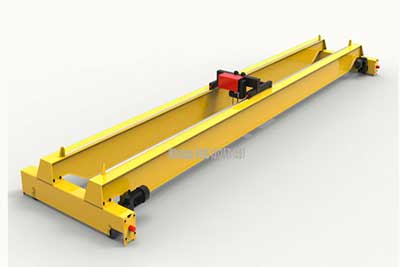
Overhead bridge crane for steel storage warehouse and storage yard
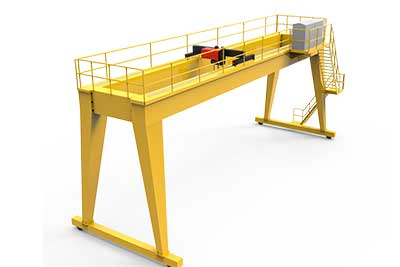
Gantry crane for steel warehouse and storage yard
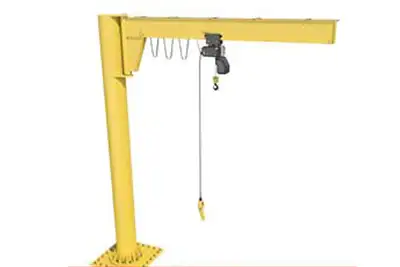
Jib crane for steel and metal handling in steel warehouse and storage yard
- Bridge Cranes: Also known as overhead traveling cranes, bridge cranes consist of a horizontal beam (the bridge) that spans the width of the warehouse, supported by parallel runways. The lifting mechanism, typically a hoist or trolley, moves along the bridge, allowing for precise positioning of heavy loads.
- Gantry Cranes: Similar to bridge cranes but with legs that support the bridge, gantry cranes offer greater mobility and versatility. They're ideal for outdoor storage yards or areas where a fixed runway system isn't feasible.
- Jib Cranes: Unlike bridge and gantry cranes, which cover a wide area, jib cranes are designed for localized lifting tasks. They consist of a vertical mast with a horizontal boom (the jib) that rotates, providing 360 degree coverage within a limited radius.
Each type of overhead crane has its advantages and applications, allowing warehouses to customize their material handling solutions based on their layout and requirements.
Overhead Cranes for Steel Storage
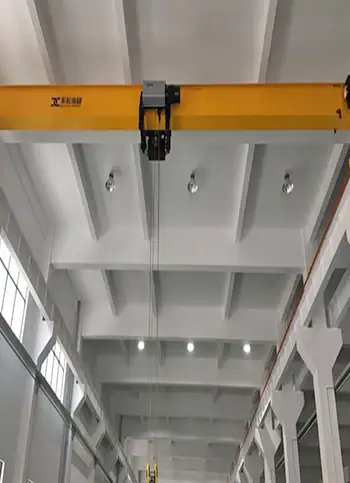
Single Girder Overhead Crane for Steel Storage
Crane Design & Capacities:
Single girder overhead cranes typically feature a single horizontal beam (girder) supported by end trucks. They are available in various lifting capacities, ranging from a few tons to around 20 tons.
Tailored Features for Steel Storages:
Adequate clearance for stacking steel materials vertically.
Precise control systems for accurate positioning of steel components.
Versatile lifting attachments for handling different types of steel products.
Applicable Industries:
Steel fabrication shops
Metalworking factories
Small to medium-sized steel warehouses
Typical Indoor Steel Handling in Storage Workshops:
Moving steel beams, plates, and coils within the workshop.
Loading and unloading trucks delivering steel materials.
Positioning steel components for fabrication or assembly processes.
Typical Outdoor Steel Handling in Storage Yards:
Transferring steel materials between outdoor storage areas and indoor workshops.
Loading steel products onto flatbed trucks or railcars for transportation.
Sorting and organizing steel inventory in outdoor storage yards.
Double Girder Overhead Crane
Crane Design & Capacities:
Double girder overhead cranes feature two horizontal beams (girders) supported by end trucks. They offer higher lifting capacities compared to single girder cranes, ranging from 20 tons to over 100 tons.
Tailored Features for Steel Storages:
Increased lifting capacity for handling heavy steel components.
Robust construction to withstand the weight and size of steel materials.
Advanced control systems for precise and efficient material handling.
Applicable Industries:
Steel mills
Large metal fabrication facilities
Steel distribution centers
Typical Indoor Steel Handling in Storage Workshops:
Lifting and moving large steel beams, coils, and machinery parts.
Transporting steel components to and from machining or welding stations.
Storing heavy steel materials in racks or shelves within the workshop.
Typical Outdoor Steel Handling in Storage Yards:
Loading and unloading steel materials from outdoor storage areas.
Transferring steel products between storage yards and manufacturing facilities.
Handling oversized steel components for shipping or storage.
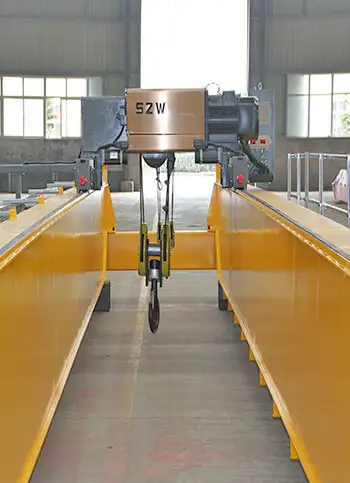
Gantry Crane
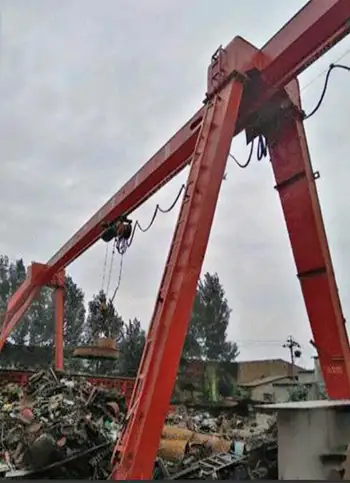
Single Girder Gantry Cranes
Crane Design & Capacities:
Single girder gantry cranes feature a single horizontal beam (girder) supported by legs or wheels mounted on rails or tracks. They come in various lifting capacities, typically ranging from a few tons to around 20 tons.
Tailored Features for Steel Storages:
Mobility for covering large outdoor steel storage areas.
Adequate clearance for stacking steel materials vertically.
Versatile lifting attachments for handling different types of steel products.
Applicable Industries:
Steel fabrication yards
Steel distribution centers
Construction sites
Typical Indoor Steel Handling in Storage Workshops:
Transporting steel materials within covered storage areas.
Loading and unloading trucks delivering steel products.
Storing steel inventory in racks or shelves within the workshop.
Typical Outdoor Steel Handling in Storage Yards:
Moving steel materials between outdoor storage areas and indoor workshops.
Loading steel products onto trucks or trailers for transportation.
Sorting and organizing steel inventory in open-air storage yards.
Double Girder Gantry Cranes
Crane Design & Capacities:
Double girder gantry cranes have two horizontal beams (girders) supported by legs or wheels mounted on rails or tracks. They offer higher lifting capacities compared to single girder gantry cranes, typically ranging from 20 tons to over 100 tons.
Tailored Features for Steel Storages:
Increased lifting capacity for handling heavy steel components.
Heavy-duty construction to withstand the weight and size of steel materials.
Advanced control systems for precise and efficient material handling.
Applicable Industries:
Large steel fabrication facilities
Steel distribution yards
Port terminals
Typical Indoor Steel Handling in Storage Workshops:
Lifting and moving large steel beams, coils, and machinery parts.
Transporting steel components to and from machining or welding stations.
Storing heavy steel materials in racks or shelves within the workshop.
Typical Outdoor Steel Handling in Storage Yards:
Loading and unloading steel materials from outdoor storage areas.
Transferring steel products between storage yards and manufacturing facilities.
Handling oversized steel components for shipping or storage.
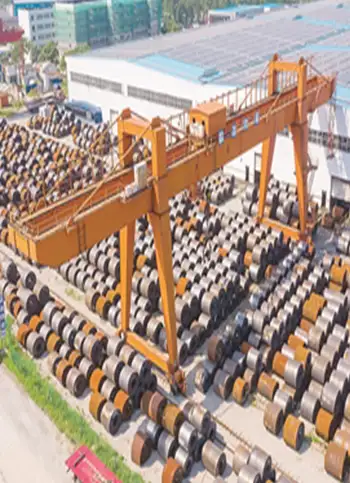

Semi Gantry Cranes
Crane Design & Capacities:
Semi gantry cranes have one end supported by a runway beam or building structure, while the other end is supported by legs or wheels mounted on rails or tracks. They come in various lifting capacities, typically ranging from a few tons to around 50 tons.
Tailored Features for Steel Storages:
Mobility for covering outdoor steel storage areas with restricted access.
Compact design for efficient use of space in steel warehouses or storage yards.
Versatile lifting attachments for handling different types of steel products.
Applicable Industries:
Small to medium-sized steel fabrication shops
Metalworking factories
Construction sites with limited space
Typical Indoor Steel Handling in Storage Workshops:
Moving steel materials within confined spaces in the workshop.
Loading and unloading trucks delivering steel products.
Storing steel inventory in racks or shelves with restricted access.
Typical Outdoor Steel Handling in Storage Yards:
Transferring steel materials between outdoor storage areas and indoor workshops.
Loading steel products onto trucks or trailers for transportation.
Sorting and organizing steel inventory in outdoor storage yards with limited access.
Rubber Tyred Gantry Cranes (RTGs)
Crane Design & Capacities:
Rubber tyred gantry cranes (RTGs) are mobile gantry cranes supported by rubber tires, allowing them to move independently along the storage yard. They come in various lifting capacities, typically ranging from 20 tons to over 100 tons.
Tailored Features for Steel Storages:
Mobility for covering large outdoor steel storage areas.
Heavy-duty construction to withstand outdoor environments.
Advanced control systems for precise and efficient material handling.
Applicable Industries:
Steel container terminals
Steel distribution yards
Port facilities handling steel products
Typical Indoor Steel Handling in Storage Workshops:
Transferring steel materials between indoor storage areas and outdoor yards.
Loading and unloading steel products onto trucks or ships.
Storing steel inventory in covered storage areas within the workshop.
Typical Outdoor Steel Handling in Storage Yards:
Moving steel coils, beams, and pipes within the outdoor storage yard.
Loading steel products onto ships or barges for transportation.
Sorting and organizing steel inventory in open-air storage areas.
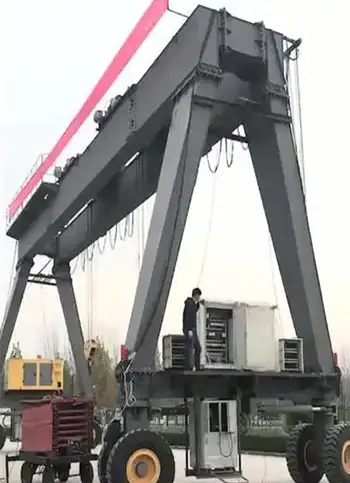
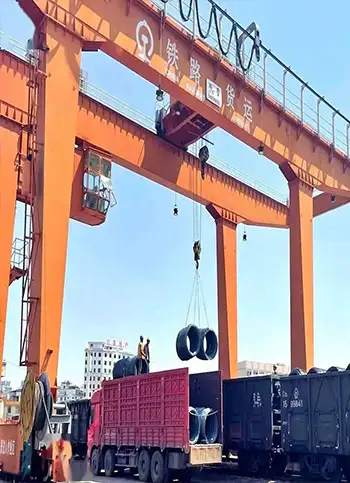
Rail Mounted Gantry Cranes (RMGs)
Crane Design & Capacities:
Rail mounted gantry cranes (RMGs) are fixed gantry cranes supported by rails or tracks, allowing them to move along predefined paths within the storage yard. They come in various lifting capacities, typically ranging from 20 tons to over 100 tons.
Tailored Features for Steel Storages:
Precise control systems for accurate positioning of steel materials.
Heavy-duty construction to withstand outdoor environments.
Versatile lifting attachments for handling different types of steel products.
Applicable Industries:
Steel container terminals
Steel distribution yards
Port facilities handling steel products
Typical Indoor Steel Handling in Storage Workshops:
Transferring steel materials between indoor storage areas and outdoor yards.
Loading and unloading steel products onto trucks or ships.
Storing steel inventory in covered storage areas within the workshop.
Typical Outdoor Steel Handling in Storage Yards:
Moving steel coils, beams, and pipes within the
outdoor storage yard.
Loading steel products onto ships or barges for transportation.
Sorting and organizing steel inventory in open-air storage areas.
Spcailized Overhead Crnaes for Steel Stroage Operations
Specialized overhead cranes for steel storage operations are designed to meet the specific needs and challenges of handling steel materials efficiently and safely. These cranes are tailored with unique features and configurations to optimize steel storage operations. Here are some examples of specialized overhead cranes for steel storage:
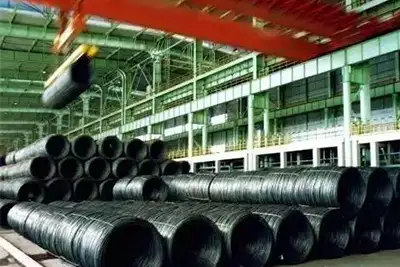
Magnetic Overhead Crane:
Features:
Equipped with an electromagnetic lifting system for lifting and moving ferrous steel materials.
Provides secure gripping and precise control over the positioning of steel components.
Suitable for handling steel plates, beams, and other magnetic steel products.
Applicable Industries: Steel mills, metal recycling facilities, steel fabrication shops.
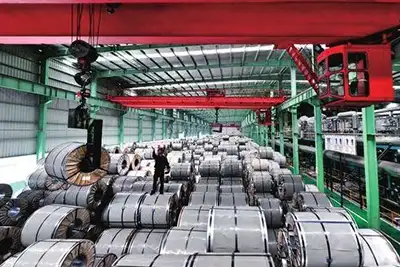
Coil Handling Overhead Crane:
Features:
Designed with specialized coil handling attachments such as coil grabs or coil lifters.
Provides stable and secure gripping of steel coils during lifting and transportation.
Offers precise control for loading and unloading steel coils onto racks or trucks.
Applicable Industries: Steel service centers, metal processing facilities, coil storage warehouses.
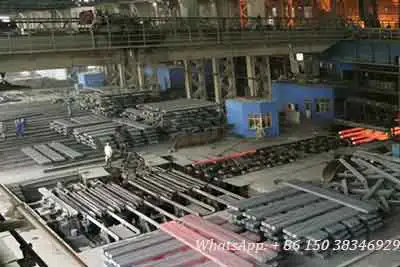
High Temperature Overhead Crane:
Features:
Constructed with heat-resistant materials to withstand high temperatures in steel mills or foundries.
Equipped with specialized insulation and cooling systems to protect crane components.
Designed for lifting and moving molten steel, ingots, or other hot steel products.
Applicable Industries: Steel foundries, forging shops, hot rolling mills.
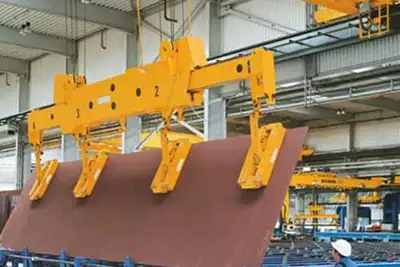
Vertical Plate Handling Overhead Crane:
Features:
Designed with a vertical lifting beam or spreader for handling large steel plates vertically.
Provides efficient stacking and retrieval of steel plates in vertical storage racks.
Offers precise control for positioning steel plates during loading, unloading, or storage operations.
Applicable Industries: Steel distribution centers, plate processing facilities, shipyards.

Anti-Corrosion Overhead Crane:
Features:
Constructed with corrosion-resistant materials or protective coatings to withstand harsh environments.
Equipped with sealed components and specialized seals to prevent moisture ingress and corrosion.
Suitable for outdoor steel storage yards or facilities exposed to corrosive elements.
Applicable Industries: Coastal steel storage yards, marine terminals, outdoor steel processing facilities.

High-Speed & Variable Speed Overhead Crane:
Features:
Designed with high-speed hoisting, trolley, and crane travel mechanisms for rapid material handling.
Offers quick cycle times and high productivity for steel storage operations with demanding throughput requirements.
Equipped with advanced control systems for precise and efficient crane movements.
Applicable Industries: Steel distribution centers, manufacturing plants, high-volume steel storage facilities.
These specialized overhead cranes are tailored to meet the unique demands of steel storage operations, providing enhanced performance, efficiency, and safety in handling steel materials.
Advantages of Overhead Cranes in Material Handling
So, why choose overhead cranes over other lifting equipment? The advantages are clear:
- Maximized Space Utilization: By operating overhead, these cranes free up valuable floor space, allowing for more efficient storage and movement of goods.
- Improved Safety: With overhead cranes, operators can lift and transport heavy loads without endangering themselves or others on the ground, reducing the risk of accidents and injuries.
- Enhanced Productivity: The ability to move heavy loads quickly and accurately translates to faster turnaround times and increased throughput, boosting overall productivity in the warehouse.
- Versatility: From lifting coils and beams to maneuvering bulky materials, overhead cranes are versatile enough to handle a wide range of tasks, making them indispensable in steel warehouses.
In essence, overhead cranes aren't just tools; they're game changers in the material handling. Their unmatched efficiency, safety, and versatility make them a must have for any steel warehouse looking to optimize its operations and stay ahead of the competition.
Factors Influencing Efficiency in Steel Storage
Efficiency in steel storage isn't just about stacking metal—it's about overcoming a myriad of challenges that can impede operations. Let's explore the key factors that influence efficiency in steel warehouses.
Space Utilization Challenges in Steel Warehouses
Steel, with its varying shapes and sizes, presents unique challenges when it comes to space utilization. Unlike standard palletized goods, steel products often require specialized storage solutions to maximize available space. Bulky beams, coils, and sheets can quickly eat up valuable floor space if not stored efficiently. Moreover, irregular shapes and sizes make it challenging to stack steel products in a uniform manner, further complicating space optimization efforts.
Productivity Limitations Without Efficient Material Handling Systems
Inefficient material handling systems can severely hamper productivity in steel warehouses. Manual lifting and transporting of heavy steel components not only slow down operations but also increase the risk of injury to workers. Moreover, without the ability to quickly and accurately move materials from storage to production areas, downtime can escalate, leading to delays in fulfilling customer orders and lost revenue opportunities. In a competitive market, every minute counts, making efficient material handling systems essential for maintaining a competitive edge.
Safety Concerns in Traditional Steel Storage Methods
Traditional steel storage methods, such as stacking materials on the ground or using manual lifting equipment, pose significant safety risks to warehouse personnel. The potential for accidents, such as slips, trips, and falls, increases when handling heavy steel components manually. Additionally, improper stacking of materials can lead to structural instability, risking collapses and injuries. Ensuring the safety of workers should always be a top priority in steel warehouses, and inefficient storage methods only exacerbate the risk.
Addressing these factors requires a holistic approach that integrates efficient storage solutions, advanced material handling systems, and stringent safety protocols. By overcoming space utilization challenges, improving productivity through streamlined operations, and prioritizing safety at every step, steel warehouses can enhance efficiency and profitability while ensuring the well being of their workforce. In the next section, we'll delve into the role of overhead cranes in mitigating these challenges and optimizing efficiency in steel storage.
Role of Overhead Cranes in Enhancing Efficiency
Overhead cranes aren't just heavy lifters—they're the linchpin of efficiency in steel warehouses. Let's delve into how these mighty machines revolutionize steel storage operations.
Maximizing Vertical Space Utilization
In steel warehouses, every inch of vertical space counts, and overhead cranes are the key to unlocking its full potential. By operating overhead, these cranes free up valuable floor space that would otherwise be occupied by traditional material handling equipment or obstructed by stacked steel components. With their ability to reach towering heights, overhead cranes enable warehouses to maximize storage capacity, stacking steel products vertically without compromising accessibility. From beams to coils, overhead cranes ensure that no space goes to waste, optimizing storage efficiency and maximizing warehouse potential.
Increasing Productivity Through Faster Material Handling
Time is money, and nowhere is this more evident than in steel warehouses. The ability to move heavy steel components quickly and efficiently directly impacts productivity and, ultimately, the bottom line. Overhead cranes excel in this regard, offering unmatched speed and precision in material handling operations. With their ability to lift and transport heavy loads with ease, overhead cranes reduce turnaround times, minimize downtime, and streamline workflow processes. Whether it's loading and unloading trucks or transferring materials between storage areas and production lines, overhead cranes are the workhorses that keep operations running smoothly.
Minimizing Manual Labor and Associated Risks
Manual labor in steel warehouses is not only physically demanding but also fraught with safety risks. Heavy lifting, repetitive tasks, and awkward postures increase the likelihood of musculoskeletal injuries among warehouse personnel. Overhead cranes alleviate these risks by minimizing the need for manual intervention in material handling operations. Instead of relying on manpower to lift and transport heavy loads, overhead cranes automate the process, reducing the physical strain on workers and mitigating the risk of injuries. By prioritizing safety and efficiency, overhead cranes create a safer and more conducive working environment for warehouse personnel.
In essence, overhead cranes are the backbone of efficiency in steel warehouses, enabling vertical space utilization, increasing productivity, and enhancing safety.
Optimizing Steel Storage Efficiency with Different Tonnages
Steel warehouses deal with a spectrum of loads, ranging from small components to hefty beams. Let's explore how overhead cranes cater to different tonnages, starting with those handling 5 ton capacities.
Overhead Cranes for Handling 5 ton Capacity
Benefits and Applications:
Versatility: Overhead cranes with 5 ton capacity strike a balance between strength and flexibility. They're capable of handling a wide range of steel components, including smaller beams, coils, and plates.
Precision: With their precise control mechanisms, these cranes are ideal for maneuvering delicate or intricately shaped steel products without causing damage.
Space Efficiency: For warehouses with limited space or narrow aisles, overhead cranes with 5 ton capacity offer a compact yet powerful solution for material handling.
Cost Effectiveness: Compared to larger cranes, those with 5 ton capacity typically have lower installation and operating costs, making them an economical choice for small to mid sized steel warehouses.
Considerations for Implementation:
Structural Considerations: Before installing an overhead crane, it's essential to assess the structural integrity of the warehouse roof and support beams to ensure they can support the weight of the crane and the loads it will handle.
Workflow Analysis: Understanding the flow of materials within the warehouse is crucial for determining the optimal placement of the overhead crane. Consider factors such as ingress and egress points, production areas, and storage zones to maximize efficiency.
Operator Training: Proper training and certification of crane operators are paramount to ensure safe and efficient operation. Training programs should cover crane operation, load handling techniques, and safety procedures to minimize the risk of accidents or damage to goods.
By leveraging overhead cranes with 5 ton capacity, steel warehouses can optimize storage efficiency, streamline material handling processes, and improve overall productivity. These versatile machines serve as the backbone of operations, offering a cost effective solution for lifting and transporting steel components of varying sizes and shapes.
Overhead Cranes for Handling 10 to 20 ton Capacity
Advantages over Lower Tonnage Cranes:
Increased Lifting Capacity: Overhead cranes with 10 to 20 ton capacity offer a significant boost in lifting power compared to their lower tonnage counterparts. This allows them to handle larger and heavier steel components with ease, reducing the need for multiple lifts or transfers.
Enhanced Efficiency: With higher lifting capacities, these cranes can complete tasks in fewer cycles, resulting in faster turnaround times and increased productivity. This efficiency gains significance in high volume steel storage environments where time is of the essence.
Greater Versatility: While lower tonnage cranes excel in handling smaller loads, overhead cranes with 10 to 20 ton capacity strike a balance between strength and flexibility. They can handle a broader range of steel products, including larger beams, coils, and fabricated structures, making them suitable for diverse storage requirements.
Improved Reach: Larger capacity cranes often come with longer spans and greater hook heights, allowing them to reach deeper into storage racks or cover larger areas within the warehouse. This extended reach enhances accessibility and facilitates efficient storage and retrieval of steel materials.
Specific Use Cases in Steel Storage:
Handling Heavy Duty Components: Overhead cranes with 10 to 20 ton capacity are ideal for lifting and maneuvering heavy duty steel components such as I beams, girders, and large structural sections. Their robust construction and high lifting capacity make them indispensable for handling these bulky items.
Loading and Unloading Trucks: In steel warehouses with frequent inbound and outbound shipments, overhead cranes in this tonnage range excel in loading and unloading trucks with efficiency and precision. Their ability to lift heavy loads directly from trucks onto storage racks or production lines streamlines logistics operations.
Container Handling: For steel warehouses involved in international trade, overhead cranes with 10 to 20 ton capacity are well suited for handling containers carrying steel materials. They can efficiently lift and transport loaded containers from trucks or railcars to designated storage areas, optimizing container handling processes.
By employing overhead cranes with 10 to 20 ton capacity, steel warehouses can tackle heavier loads, streamline material handling operations, and enhance overall efficiency. These versatile machines offer superior lifting power and flexibility, making them indispensable assets in the quest for optimized steel storage.
Overhead Cranes for Handling 30 to 50 ton Capacity
Handling Larger Steel Components Efficiently:
Heavy Duty Lifting: Overhead cranes with 30 to 50 ton capacity are designed to handle the heaviest steel components efficiently. These components may include massive beams, oversized coils, or large machinery parts that require robust lifting solutions.
Increased Productivity: With their high lifting capacity, these cranes can move substantial loads in a single operation, minimizing downtime and maximizing productivity. In industries where large scale steel fabrication or assembly is common, such as shipbuilding or construction, these cranes play a crucial role in streamlining operations.
Precision Control: Despite their immense lifting power, overhead cranes in this tonnage range offer precise control and maneuverability, allowing operators to position large steel components with accuracy and finesse. This level of control is essential for ensuring safety and preventing damage to delicate materials during handling.
Safety and Structural Considerations at Higher Tonnages:
Structural Integrity: Installing overhead cranes with 30 to 50 ton capacity requires careful consideration of the warehouse's structural integrity. The building's framework, including columns, beams, and roof supports, must be capable of withstanding the additional weight and forces exerted by these heavy duty cranes.
Crane Configuration: Cranes in this tonnage range often feature larger spans and higher hook heights to accommodate oversized loads. It's essential to ensure that the crane's configuration aligns with the warehouse layout and operational requirements to optimize performance and safety.
Operator Training: Operating overhead cranes with 30 to 50 ton capacity requires specialized training and expertise due to the significant risks involved. Operators must undergo comprehensive training programs covering crane operation, load handling techniques, and safety procedures to minimize the risk of accidents or injuries.
Safety Features: Modern overhead cranes come equipped with a range of safety features, including overload protection systems, emergency stop buttons, and collision avoidance sensors. Regular maintenance and inspection are essential to ensure that these safety systems are functioning correctly and effectively mitigate risks in high capacity lifting operations.
While overhead cranes with 30 to 50 ton capacity offer unparalleled lifting power and efficiency in handling large steel components, safety considerations are paramount. By prioritizing structural integrity, operator training, and safety features, steel warehouses can harness the full potential of these heavy duty cranes while ensuring a safe and productive working environment.
Overhead Cranes Operation for steel storages Accross Different Industrial Sectors
Steel storage requirements vary across different workshops and industrial sectors depending on the types of steel products being manufactured, processed, or utilized. Here are some typical types of steel that need to be stored in different workshops or yards across various industrial sectors, along with the typical features, designs of overhead cranes used for handling each type of steel, and typical steel handling devices used in each sector:
Manufacturing Sector:
Types of Steel: Raw steel materials, steel bars, sheets, coils, plates.
Typical Overhead Crane Features:
High lifting capacity to handle heavy steel materials.
Precision controls for accurate positioning of steel components.
Safety features such as overload protection and emergency stop controls.
Typical Steel Handling Devices: Forklifts, pallet jacks, steel storage racks, conveyors.
Construction Sector:
Types of Steel: Structural steel beams, columns, reinforcement bars (rebar).
Typical Overhead Crane Features:
Long span length to cover large construction sites.
High lifting capacity to handle bulky steel components.
Robust construction to withstand outdoor environments.
Typical Steel Handling Devices: Mobile cranes, tower cranes, gantry cranes, steel erection equipment.
Metal Fabrication Sector:
Types of Steel: Sheet metal, tubing, pipes, fabricated steel components.
Typical Overhead Crane Features:
Variable speed controls for precise material handling.
Customizable lifting attachments for different types of steel products.
Integration with cutting and welding equipment for seamless fabrication processes.
Typical Steel Handling Devices: Material handling carts, roller conveyors, hydraulic lifts, manipulators.
Warehousing and Distribution Sector:
Types of Steel: Finished goods, packaged steel products, steel inventory.
Typical Overhead Crane Features:
Efficient space utilization with compact designs.
Quick lifting and positioning capabilities for high-volume operations.
Integration with warehouse management systems for inventory tracking.
Typical Steel Handling Devices: Pallet racks, cantilever racks, pallet inverters, palletizers.
Shipping and Logistics Sector:
Types of Steel: Steel coils, sheets, bars, tubes, pipes.
Typical Overhead Crane Features:
Specialized lifting attachments for handling steel coils securely.
Heavy-duty construction to withstand marine environments.
Advanced safety features for handling oversized and heavy steel loads.
Typical Steel Handling Devices: Coil lifters, coil cars, transfer carts, container cranes.
Mining and Extraction Sector:
Types of Steel: Mining equipment, machinery parts, structural components.
Typical Overhead Crane Features:
High lifting capacity to handle heavy mining equipment.
Rugged construction to withstand harsh mining environments.
Precise controls for safe and efficient material handling.
Typical Steel Handling Devices: Front-end loaders, haul trucks, conveyor belts, bucket elevators.
In summary, the types of steel stored in workshops and yards across different industrial sectors vary widely, ranging from raw materials to finished products. The overhead cranes and steel handling devices used in each sector are designed to meet the specific requirements and challenges associated with handling different types of steel materials, ensuring efficient and safe operations in diverse industrial environments.
Typical Overhead Crane Designs for Different Steel Objects Handling
For different types of steel products handling in different storage workshops or yards, there are speical overhead crane are used which are processed based on the steel features, application evironment,typical features. Here's an overview of typical overhead crane designs, features, and devices used for handling different types of steel products in various storage workshops or yards:
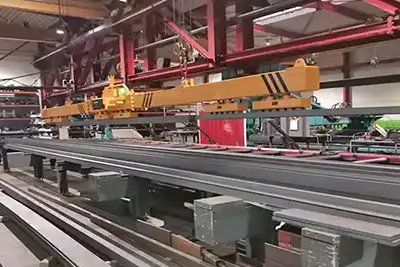
Steel Beam Handling:
Typical Overhead Crane Design: Double girder overhead crane with a specialized spreader beam attachment for lifting and transporting steel beams.
Typical Features: High lifting capacity, precision controls for accurate positioning, adjustable spreader beams for different beam sizes.
Typical Devices: Spreader beams, C-hooks, lifting clamps.
Typical Warehouse Applications: Steel fabrication shops, construction sites, warehouses storing structural steel components.
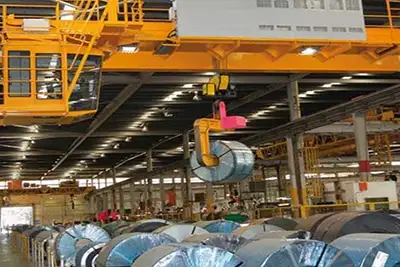
Steel Coil Handling:
Typical Overhead Crane Design: Double girder overhead crane with a coil grab or coil lifter attachment.
Typical Features: Specialized coil handling attachments, anti-sway technology to prevent coil swinging, precise control for delicate handling.
Typical Devices: Coil grab, coil lifter, coil hook.
Typical Warehouse Applications: Steel processing facilities, steel service centers, warehouses handling steel coils for manufacturing or distribution.
Typical Overhead Crane Design: Double girder overhead crane with a coil grab or coil lifter attachment.
Typical Features: Specialized coil handling attachments, anti-sway technology to prevent coil swinging, precise control for delicate handling.
Typical Devices: Coil grab, coil lifter, coil hook.
Typical Warehouse Applications: Steel processing facilities, steel service centers, warehouses handling steel coils for manufacturing or distribution.

Steel Plate Handling:
Typical Overhead Crane Design: Double girder overhead crane with a lifting magnet or vacuum lifter attachment.
Typical Features: Powerful lifting magnets or vacuum lifters for secure gripping, adjustable lifting points for different plate sizes, precision controls for accurate placement.
Typical Devices: Lifting magnets, vacuum lifters, plate clamps.
Typical Warehouse Applications: Metal fabrication shops, steel distribution centers, warehouses handling steel plates for cutting, bending, or welding processes.
Typical Overhead Crane Design: Double girder overhead crane with a lifting magnet or vacuum lifter attachment.
Typical Features: Powerful lifting magnets or vacuum lifters for secure gripping, adjustable lifting points for different plate sizes, precision controls for accurate placement.
Typical Devices: Lifting magnets, vacuum lifters, plate clamps.
Typical Warehouse Applications: Metal fabrication shops, steel distribution centers, warehouses handling steel plates for cutting, bending, or welding processes.
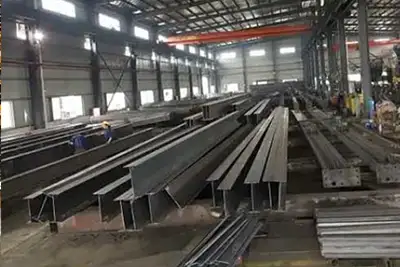
Structural Steel Handling (I-Beams, Channels, etc.):
Typical Overhead Crane Design: Double girder overhead crane with custom lifting attachments for various structural shapes.
Typical Features: Versatile lifting attachments for different structural shapes, adjustable hooks or clamps for secure lifting, precision controls for precise positioning.
Typical Devices: Custom lifting attachments, spreader beams, C-hooks.
Typical Warehouse Applications: Steel construction sites, steel fabrication yards, warehouses storing and processing structural steel components for building projects.
Typical Overhead Crane Design: Double girder overhead crane with custom lifting attachments for various structural shapes.
Typical Features: Versatile lifting attachments for different structural shapes, adjustable hooks or clamps for secure lifting, precision controls for precise positioning.
Typical Devices: Custom lifting attachments, spreader beams, C-hooks.
Typical Warehouse Applications: Steel construction sites, steel fabrication yards, warehouses storing and processing structural steel components for building projects.
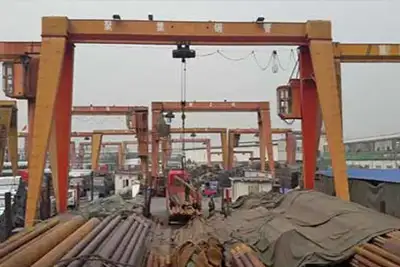
Pipe and Tube Handling:
Typical Overhead Crane Design: Single or double girder overhead crane with a pipe grab or pipe hook attachment.
Typical Features: Specialized attachments for handling cylindrical loads, adjustable grips for different pipe diameters, anti-sway technology for stable lifting.
Typical Devices: Pipe grab, pipe hook, pipe clamp.
Typical Warehouse Applications: Pipe manufacturing plants, steel distribution centers, warehouses handling pipes and tubes for construction or industrial applications.
Typical Overhead Crane Design: Single or double girder overhead crane with a pipe grab or pipe hook attachment.
Typical Features: Specialized attachments for handling cylindrical loads, adjustable grips for different pipe diameters, anti-sway technology for stable lifting.
Typical Devices: Pipe grab, pipe hook, pipe clamp.
Typical Warehouse Applications: Pipe manufacturing plants, steel distribution centers, warehouses handling pipes and tubes for construction or industrial applications.
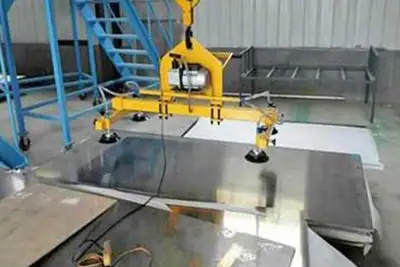
Sheet Metal Handling:
Typical Overhead Crane Design: Single or double girder overhead crane with a vacuum lifter or sheet lifter attachment.
Typical Features: Large suction cups or gripping plates for secure handling of flat sheets, adjustable lifting points for different sheet sizes, precision controls for accurate placement.
Typical Devices: Vacuum lifter, sheet lifter, plate clamps.
Typical Warehouse Applications: Metal fabrication shops, automotive manufacturing plants, warehouses processing and storing sheet metal for various applications.
Typical Overhead Crane Design: Single or double girder overhead crane with a vacuum lifter or sheet lifter attachment.
Typical Features: Large suction cups or gripping plates for secure handling of flat sheets, adjustable lifting points for different sheet sizes, precision controls for accurate placement.
Typical Devices: Vacuum lifter, sheet lifter, plate clamps.
Typical Warehouse Applications: Metal fabrication shops, automotive manufacturing plants, warehouses processing and storing sheet metal for various applications.
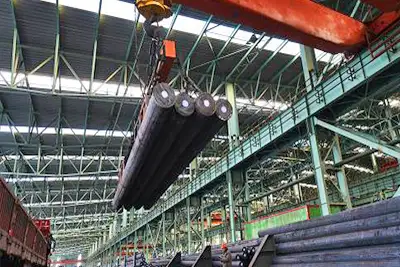
Steel Bar and Rod Handling:
Typical Overhead Crane Design: Single or double girder overhead crane with a lifting magnet or specialized bar handling attachment.
Typical Features: Strong lifting magnets or bar handling attachments for secure gripping, adjustable lifting points for different bar lengths, precision controls for accurate positioning.
Typical Devices: Lifting magnets, bar handling attachments, bar hooks.
Typical Warehouse Applications: Steel mills, metal fabrication shops, warehouses handling steel bars and rods for manufacturing or construction projects.
Typical Overhead Crane Design: Single or double girder overhead crane with a lifting magnet or specialized bar handling attachment.
Typical Features: Strong lifting magnets or bar handling attachments for secure gripping, adjustable lifting points for different bar lengths, precision controls for accurate positioning.
Typical Devices: Lifting magnets, bar handling attachments, bar hooks.
Typical Warehouse Applications: Steel mills, metal fabrication shops, warehouses handling steel bars and rods for manufacturing or construction projects.
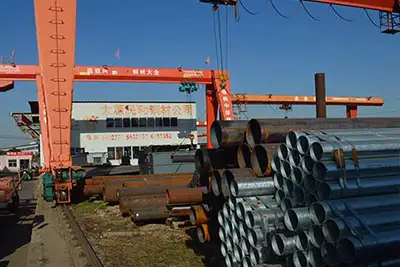
Steel Pipe Rack Loading/Unloading:
Typical Overhead Crane Design: Gantry crane with a telescopic spreader beam or pipe handling attachment.
Typical Features: Telescopic spreader beams for reaching multiple layers of pipe racks, adjustable grips for different pipe lengths and diameters, precise controls for smooth loading/unloading.
Typical Devices: Telescopic spreader beam, pipe handling attachment, pipe hook.
Typical Warehouse Applications: Pipe yards, construction sites, warehouses handling steel pipes for oil and gas, water distribution, or structural applications.
Typical Overhead Crane Design: Gantry crane with a telescopic spreader beam or pipe handling attachment.
Typical Features: Telescopic spreader beams for reaching multiple layers of pipe racks, adjustable grips for different pipe lengths and diameters, precise controls for smooth loading/unloading.
Typical Devices: Telescopic spreader beam, pipe handling attachment, pipe hook.
Typical Warehouse Applications: Pipe yards, construction sites, warehouses handling steel pipes for oil and gas, water distribution, or structural applications.
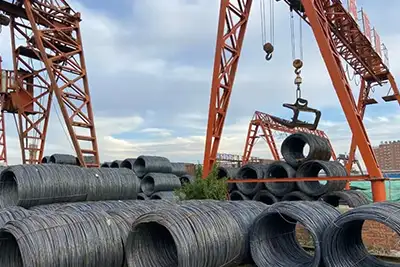
Wire Coil Handling:
Typical Overhead Crane Design: Single or double girder overhead crane with a wire coil grab or mandrel attachment.
Typical Features: Specialized grabs or mandrels for gripping wire coils securely, anti-sway technology for stable lifting and positioning, adjustable grips for different coil diameters.
Typical Devices: Wire coil grab, coil mandrel, coil hook.
Typical Warehouse Applications: Wire mills, metal processing facilities, warehouses handling wire coils for manufacturing of springs, cables, and wire products.
Typical Overhead Crane Design: Single or double girder overhead crane with a wire coil grab or mandrel attachment.
Typical Features: Specialized grabs or mandrels for gripping wire coils securely, anti-sway technology for stable lifting and positioning, adjustable grips for different coil diameters.
Typical Devices: Wire coil grab, coil mandrel, coil hook.
Typical Warehouse Applications: Wire mills, metal processing facilities, warehouses handling wire coils for manufacturing of springs, cables, and wire products.

Steel Billet Handling:
Typical Overhead Crane Design: Double girder overhead crane with a specialized billet handling attachment.
Typical Features: Custom-designed attachments for lifting and transporting steel billets, adjustable grips for different billet sizes, precision controls for accurate placement.
Typical Devices: Billet handling attachment, lifting tongs, billet hook.
Typical Warehouse Applications: Steel foundries, forging shops, warehouses handling steel billets for casting, forging, or rolling processes.
Typical Overhead Crane Design: Double girder overhead crane with a specialized billet handling attachment.
Typical Features: Custom-designed attachments for lifting and transporting steel billets, adjustable grips for different billet sizes, precision controls for accurate placement.
Typical Devices: Billet handling attachment, lifting tongs, billet hook.
Typical Warehouse Applications: Steel foundries, forging shops, warehouses handling steel billets for casting, forging, or rolling processes.

Steel Scrap Handling:
Typical Overhead Crane Design: Double girder overhead crane with a clamshell bucket or electromagnet attachment.
Typical Features: Clamshell bucket or electromagnet for grabbing and lifting scrap metal, heavy-duty construction for handling large volumes of scrap, precise controls for efficient material handling.
Typical Devices: Clamshell bucket, electromagnet, scrap grab.
Typical Warehouse Applications: Scrap yards, metal recycling facilities, steel mills processing scrap metal for reuse in manufacturing processes.
Typical Overhead Crane Design: Double girder overhead crane with a clamshell bucket or electromagnet attachment.
Typical Features: Clamshell bucket or electromagnet for grabbing and lifting scrap metal, heavy-duty construction for handling large volumes of scrap, precise controls for efficient material handling.
Typical Devices: Clamshell bucket, electromagnet, scrap grab.
Typical Warehouse Applications: Scrap yards, metal recycling facilities, steel mills processing scrap metal for reuse in manufacturing processes.
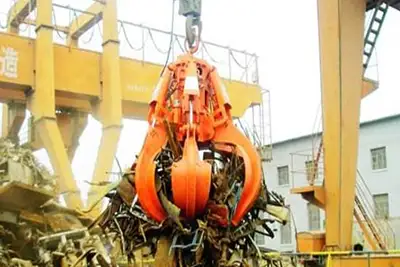
Specialty Steel Products (Forgings, Castings, etc.):
Typical Overhead Crane Design: Custom-designed overhead crane with specialized lifting fixtures or attachments.
Typical Features: Tailored lifting fixtures or attachments for handling unique shapes and sizes of specialty steel products, precise controls for delicate handling, safety features for secure lifting.
Typical Devices: Custom lifting fixtures, specialized attachments, lifting beams.
Typical Warehouse Applications: Specialty steel manufacturing facilities, foundries, warehouses handling custom forgings, castings, or other specialty steel products.
Typical Overhead Crane Design: Custom-designed overhead crane with specialized lifting fixtures or attachments.
Typical Features: Tailored lifting fixtures or attachments for handling unique shapes and sizes of specialty steel products, precise controls for delicate handling, safety features for secure lifting.
Typical Devices: Custom lifting fixtures, specialized attachments, lifting beams.
Typical Warehouse Applications: Specialty steel manufacturing facilities, foundries, warehouses handling custom forgings, castings, or other specialty steel products.
The choice of overhead crane design, features, and devices for handling different types of steel products in storage workshops or yards depends on the specific characteristics of the steel products, such as size, shape, weight, and material handling requirements. Each overhead crane setup is tailored to meet the unique challenges and demands of handling specific types of steel products safely and efficiently.
In conclusion, the handling of various types of steel products in storage workshops or yards requires careful consideration of the specific characteristics and handling requirements of each product. By selecting the appropriate overhead crane design, features, and devices, storage facilities can ensure safe, efficient, and precise handling of steel products, optimizing workflow processes and maximizing productivity.
Quantifiable Improvements in Storage Efficiency and Productivity:
- Storage Capacity Utilization: By implementing overhead cranes, steel warehouses have reported up to a 30% increase in storage capacity utilization. Vertical space, which was previously underutilized, is now efficiently utilized, allowing warehouses to store more steel products without expanding their physical footprint.
- Productivity Gains: Steel warehouses equipped with overhead cranes have experienced a 20% to 40% increase in productivity. The ability to move heavy loads quickly and accurately has reduced material handling times, minimized downtime, and streamlined workflow processes, resulting in higher output levels and improved customer satisfaction.
These case studies and quantifiable improvements demonstrate the tangible benefits of implementing overhead cranes in steel warehouses. From optimizing storage efficiency to boosting productivity, overhead cranes are instrumental in driving operational excellence and positioning steel warehouses for success in a competitive market.
Challenges and Solutions
Implementing overhead cranes in steel warehouses isn't without its hurdles, but innovative solutions and best practices can overcome these challenges. Let's explore common obstacles and how to address them effectively.
Common Challenges Faced in Implementing Overhead Cranes:
- Structural Limitations: Solution: Conduct a thorough structural assessment to ensure the building can withstand the crane's weight and forces. Reinforce critical areas if necessary, or consider alternative crane configurations that minimize structural impact.
- Space Constraints: Solution: Optimize warehouse layout and storage configurations to accommodate overhead crane installations. Consider reorganizing storage racks or investing in compact crane designs tailored to tight spaces.
- Safety Concerns: Solution: Implement comprehensive safety protocols, including operator training, regular equipment inspections, and the installation of safety features such as collision avoidance systems and overload protection devices.
Innovative Solutions and Best Practices for Overcoming Obstacles:
- Advanced Technology Integration: Solution: Embrace technological advancements such as automation, remote monitoring, and predictive maintenance to enhance crane performance and safety. Implement smart systems that optimize crane operations, minimize downtime, and proactively identify maintenance issues before they escalate.
- Customized Crane Designs: Solution: Work with crane manufacturers to develop customized designs tailored to specific warehouse requirements. Consider factors such as load capacities, span lengths, and operational constraints to ensure optimal crane performance and efficiency.
- Collaborative Work Environments: Solution: Foster a culture of collaboration and communication among warehouse personnel, crane operators, and management. Encourage feedback and input from frontline workers to identify potential safety hazards or operational inefficiencies and implement collaborative solutions.
- Continuous Improvement Initiatives: Solution: Implement continuous improvement initiatives aimed at optimizing crane operations and addressing emerging challenges. Regularly review operational processes, conduct performance assessments, and seek feedback from stakeholders to identify areas for refinement and enhancement.
By acknowledging common challenges and adopting innovative solutions and best practices, steel warehouses can successfully implement overhead cranes to optimize efficiency, improve safety, and drive operational excellence. With careful planning and proactive measures, overhead cranes become invaluable assets in the pursuit of productivity and profitability in the steel industry.
Conclusion
In conclusion, overhead cranes emerge as indispensable assets in the quest to optimize steel storage efficiency. From maximizing vertical space utilization to streamlining material handling operations, these mighty machines revolutionize warehouse management in the steel industry.
Overhead cranes serve as catalysts for efficiency and productivity in steel warehouses. They enable warehouses to maximize storage capacity, increase productivity, and enhance safety. By lifting heavy loads with precision and speed, overhead cranes streamline material handling processes, reduce downtime, and improve overall operational efficiency. Whether handling small components or hefty beams, overhead cranes are the cornerstone of storage optimization in the steel industry.
In essence, overhead cranes represent just one facet of the technological revolution sweeping through the steel industry. By harnessing the power of technology and embracing innovation, steel warehouses can unlock new levels of efficiency, sustainability, and success in the dynamic and competitive marketplace.
Main Projects
Related Products

Supplied three grab bucket crane kits to Indonesia, enhancing garbage handling efficiency with high load capacity and reliable performance.
Free consultation to Confirm Parameters & Specifications and Get
Latest Crane Price & Crane Rate.
- Types of overhead cranes : _______?
- Optional: Overhead travelling crane, goliath gantry crane,Slewing jib crane, Single girder or double girder crane,small portable crane or kbk crane, etc.
- Capacity of overhead crane: _______?
- Optional: 0.25ton, 0.5 ton, 1 ton, 2 ton, 3ton, 5 ton, 10 ton,15ton, 20ton, 25 ton, 30ton,35ton, up to 550ton, etc.
- Crane span & lifting height : _______?
- Crane travelling length : _____?
- Control of overhead crane:_______?
- Optional: pendant/ remote/cabin control
- Voltage supply of overhead crane:_____?
- Eg,: 380V50/60HZ,3Phase or others,etc.
- Application/usage of crane:_______?
- Eg,: Steel mill, ,injection mold, cement,stone, concrete,granite, general manufacturing, etc.
Just leave a message via the contact form and our hoist and crane engineer will contact you with in 24working hours.
Get In Touch
